Introduction
Timelines are powerful visual tools used to represent sequences of events over time. They are invaluable in various contexts, from historical education to project management and personal storytelling. This tutorial will guide you through the key concepts of timelines, their diverse applications, and how to create them effectively using tools like Visual Paradigm Smart Board.
Key Concepts of Timelines
1. Structure of a Timeline
A timeline typically consists of the following elements:
- Theme: The central topic or subject of the timeline.
- Start Date: The beginning point of the timeline.
- End Date: The concluding point of the timeline.
- Events: Key occurrences or milestones within the timeline.
- Details: Additional information about each event.
2. Components of an Event
Each event on a timeline usually includes:
- Date: The specific time when the event occurred.
- Description: A brief explanation of the event.
- Significance: The importance or impact of the event.
Applications of Timelines
1. Historical Contexts
Timelines are widely used in education to illustrate historical events. They help students understand the chronological order and significance of key happenings, making complex historical narratives more accessible.
2. Project Management
In project management, timelines are essential for outlining milestones, deadlines, and dependencies. They facilitate efficient planning and execution by providing a clear visual representation of the project’s progress.
3. Business Strategies
Businesses use timelines to showcase the evolution of products, company milestones, or market trends. This aids in strategic planning and communication, offering a structured view of the company’s journey.
4. Personal Storytelling
Individuals use timelines to narrate their personal journeys, such as career progression, educational achievements, and significant life events. This visual representation serves as a dynamic storytelling device, enabling self-reflection and goal-setting.
Creating Timelines with Visual Paradigm Smart Board
1. Getting Started
- Sign Up/Login: Begin by signing up or logging into Visual Paradigm Smart Board.
- Create a New Timeline: Navigate to the dashboard and select the option to create a new timeline.
2. Defining the Theme
- Set the Theme: Enter the central topic or subject of your timeline. For example, “Timeline of NGO Organization”
3. Setting the Timeframe
- Start Date: Input the beginning date of your timeline.
- End Date: Input the concluding date of your timeline.
4. Adding Events
- Event Date: Specify the date of the event.
- Event Description: Provide a brief explanation of the event.
- Event Significance: Describe the importance or impact of the event.
5. Customizing the Timeline
- Visual Elements: Use the tool’s features to add visual elements like icons, images, and color-coding to enhance the timeline’s appearance.
- Interactive Features: Incorporate interactive features such as clickable links or pop-up details for a more engaging experience.
6. Review and Finalize
- Review: Carefully review the timeline for accuracy and completeness.
- Finalize: Make any necessary adjustments and finalize the timeline.
Example: Creating a Timeline of NGO Organization
Step-by-Step Guide
- Define the Theme: “Timeline of NGO Organization”
- Set the Timeframe:
- Start Date: 1987
- End Date: 2012
- Add Events:
- 1987 – Company Inception:
- Initial community outreach programs launched.
- Formation of core team and organizational structure.
- Initial fundraising campaigns to support initiatives.
- 1992 – Pioneering Sustainable Development:
- Implemented eco-friendly projects.
- First community-based sustainable agriculture project.
- Advocacy for environmental protection.
- 1998 – Global Partnerships:
- Collaborated with global NGOs and agencies.
- Joint initiatives for healthcare and education.
- Enhanced reach and impact on a global scale.
- 2005 – Technological Integration:
- Implemented digital education programs.
- Utilized technology for efficient project management.
- Introduced online fundraising initiatives.
- 2012 – Expansion and Diversification:
- Increased focus on women’s empowerment.
- Diversified healthcare services in underserved areas.
- Extended support to marginalized communities.
- 1987 – Company Inception:
Customizing the Timeline
- Visual Elements: Add icons representing different phases of the organization’s development. Use color-coding to differentiate between various types of initiatives and achievements.
- Interactive Features: Include clickable links to detailed reports or websites for more information on each event.
Review and Finalize
- Review: Ensure all dates, descriptions, and significance are accurate.
- Finalize: Make any necessary adjustments and finalize the timeline.
Conclusion
Timelines are versatile tools that enhance understanding and communication across various disciplines. By following this tutorial, you can create effective timelines for historical education, project management, business strategies, and personal storytelling. Utilizing tools like Visual Paradigm Smart Board streamlines the process, allowing you to craft dynamic and engaging timelines with ease.
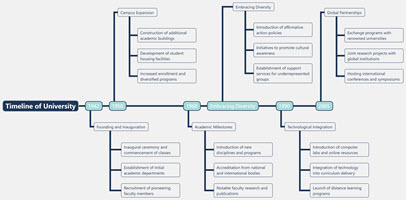
Timeline of University Edit This Template
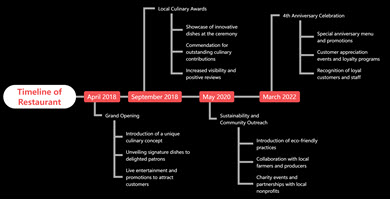
Timeline of Restaurant Edit This Template
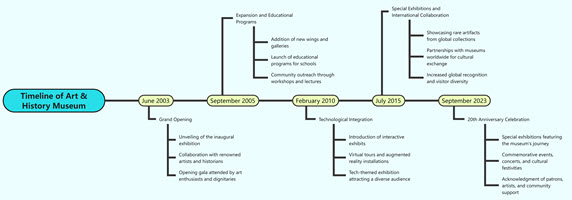
Timeline of Art & History Museum Edit This Template

Timeline of Coffee House Edit This Template
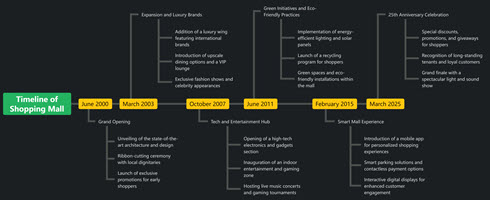
Timeline of Shopping Mall Edit This Template

Timeline of Bar Edit This Template
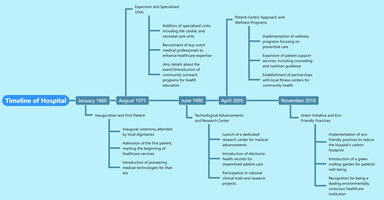
Timeline of Hospital Edit This Template
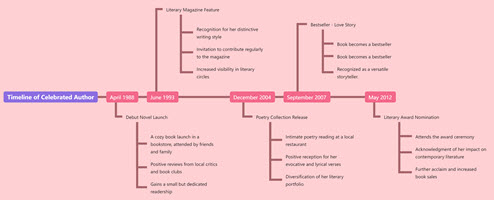
Timeline of Celebrated Author Edit This Template
